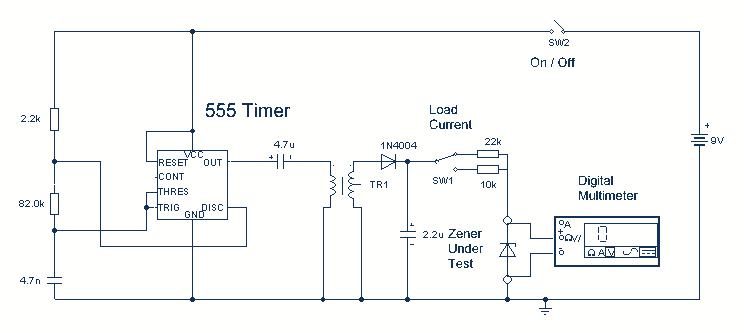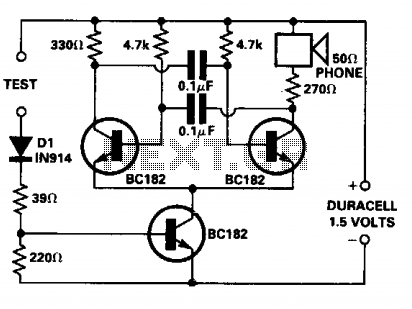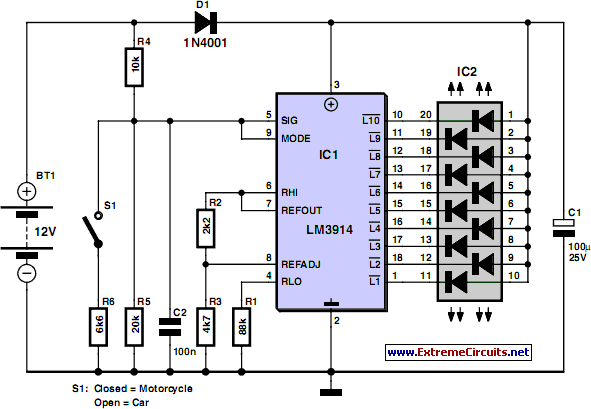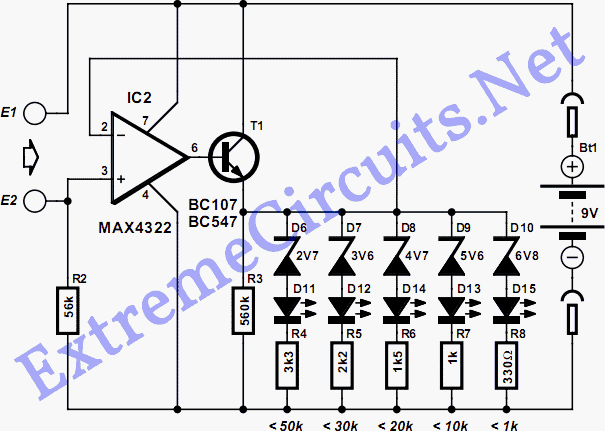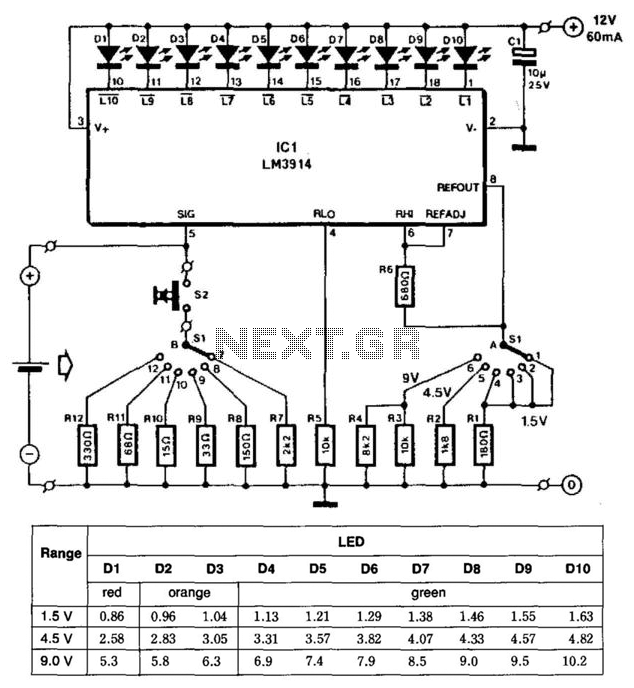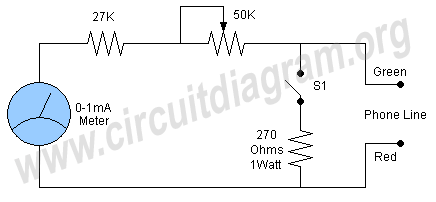
Three phase tester
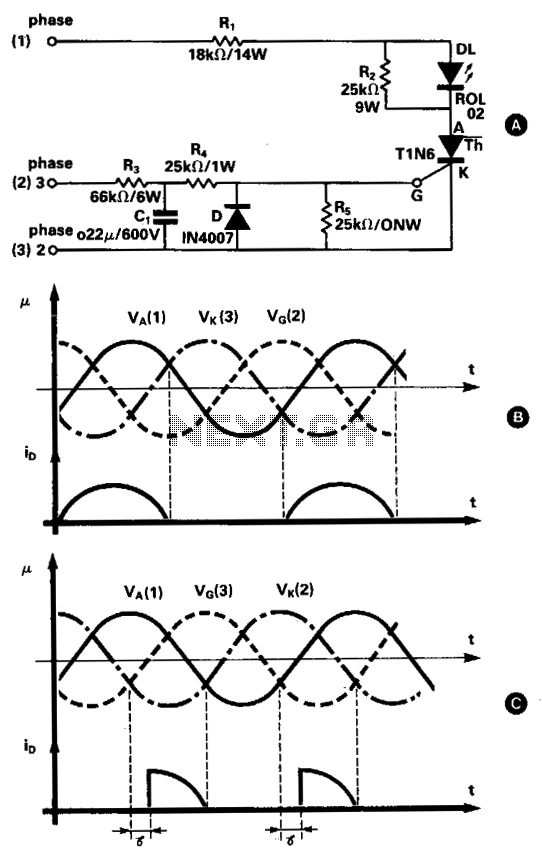
This simple three-phase tester utilizes a small current thyristor as the main component for verifying the correct or incorrect sequence of the three phases, eliminating the need for an additional power supply. The basic circuit is depicted in Fig. 69-4A. When the thyristor anode, gate, and cathode are connected in the sequence of phase 1, phase 3, and phase 2, it is considered correct, and the average current through the thyristor is relatively high, as it remains on for an entire half-period of one phase. Consequently, the LED will emit a normal light. The voltage waveforms for the three phases and the current through the LED in this scenario are illustrated in Fig. 69-4B. If the phases are incorrectly connected—such as phase 1 to the anode, phase 2 to the gate, and phase 3 to the cathode—the thyristor will activate for a very brief duration, resulting in a dim LED. The waveforms for this situation are shown in Fig. 69-4C. The delay time is determined by the R3-R1-R4 resistor group. In the event that any of the three phases is absent, no current will flow through the thyristor, and the LED will not emit any light.
This three-phase tester circuit is designed to verify the correct sequence of phase connections in a three-phase power system. The thyristor serves as a critical element that responds to the phase sequence, allowing for a simple visual indication through the LED.
The circuit operates by connecting the three phases to the thyristor's anode, gate, and cathode. When the phases are connected in the correct order (phase 1 to anode, phase 3 to gate, and phase 2 to cathode), the thyristor remains in the conducting state for a significant portion of the AC cycle, which ensures a stable flow of current through the LED. This results in a normal brightness of the LED, indicating that the phase sequence is correct. The accompanying voltage waveforms, as illustrated in Fig. 69-4B, demonstrate the expected behavior of the circuit under these conditions.
Conversely, if the phases are misconfigured, the thyristor will only conduct for a very short period. This reduced conduction time leads to a significantly lower average current through the LED, causing it to emit a dim light. The waveforms for this incorrect connection scenario, as shown in Fig. 69-4C, highlight the difference in operation when the phase sequence is not adhered to.
The timing characteristics of the circuit are influenced by the resistor network formed by R3, R1, and R4, which establishes the delay time for the thyristor's response. Additionally, if any of the three phases is missing from the circuit, the thyristor will not receive the necessary current to operate, resulting in the LED remaining off.
Overall, this three-phase tester provides a straightforward and effective method for ensuring proper phase sequence in three-phase systems, making it an invaluable tool for electrical engineers and technicians working with such installations.This simple three-phase tester, uses only a small current thyristor as a main element for testing the right or wrong succession of the three phases, and there is no need for a supplementary power supply. The basic circuit is shown in Fig. 69-4A. When connecting to the thyristor anode, grid, and cathode the three phases of the supply network in the sequence phase 1, phase 3, phase 2, are considered as correct, the mean value of the current through the thyristor is relatively high (since it is turned on during an entire half-period of one phase).
The result is that the LED will emit a normal light. The wave shapes for the three voltages and the current through the LED for this situation are shown in Fig. 69-4B. If the three phases are not correctly connected—phase 1 to the anode, phase 2 to the grid, and phase 3 to the cathode, for instance—the thyristor will be turned on for a very short time and the LED wili produce a very poor light. The wave shapes for this case are shown in Fig. 69-4C. The delay time is given by the R3-R1-R4 group. When any of the three phases is missing, there is no current through the thyristor and the LED will emit no light.
🔗 External reference
This three-phase tester circuit is designed to verify the correct sequence of phase connections in a three-phase power system. The thyristor serves as a critical element that responds to the phase sequence, allowing for a simple visual indication through the LED.
The circuit operates by connecting the three phases to the thyristor's anode, gate, and cathode. When the phases are connected in the correct order (phase 1 to anode, phase 3 to gate, and phase 2 to cathode), the thyristor remains in the conducting state for a significant portion of the AC cycle, which ensures a stable flow of current through the LED. This results in a normal brightness of the LED, indicating that the phase sequence is correct. The accompanying voltage waveforms, as illustrated in Fig. 69-4B, demonstrate the expected behavior of the circuit under these conditions.
Conversely, if the phases are misconfigured, the thyristor will only conduct for a very short period. This reduced conduction time leads to a significantly lower average current through the LED, causing it to emit a dim light. The waveforms for this incorrect connection scenario, as shown in Fig. 69-4C, highlight the difference in operation when the phase sequence is not adhered to.
The timing characteristics of the circuit are influenced by the resistor network formed by R3, R1, and R4, which establishes the delay time for the thyristor's response. Additionally, if any of the three phases is missing from the circuit, the thyristor will not receive the necessary current to operate, resulting in the LED remaining off.
Overall, this three-phase tester provides a straightforward and effective method for ensuring proper phase sequence in three-phase systems, making it an invaluable tool for electrical engineers and technicians working with such installations.This simple three-phase tester, uses only a small current thyristor as a main element for testing the right or wrong succession of the three phases, and there is no need for a supplementary power supply. The basic circuit is shown in Fig. 69-4A. When connecting to the thyristor anode, grid, and cathode the three phases of the supply network in the sequence phase 1, phase 3, phase 2, are considered as correct, the mean value of the current through the thyristor is relatively high (since it is turned on during an entire half-period of one phase).
The result is that the LED will emit a normal light. The wave shapes for the three voltages and the current through the LED for this situation are shown in Fig. 69-4B. If the three phases are not correctly connected—phase 1 to the anode, phase 2 to the grid, and phase 3 to the cathode, for instance—the thyristor will be turned on for a very short time and the LED wili produce a very poor light. The wave shapes for this case are shown in Fig. 69-4C. The delay time is given by the R3-R1-R4 group. When any of the three phases is missing, there is no current through the thyristor and the LED will emit no light.
🔗 External reference
